Saccharomyces cerevisiae MPS2 encodes a membrane protein localized at the spindle pole body and the nuclear envelope
- PMID: 10397772
- PMCID: PMC25459
- DOI: 10.1091/mbc.10.7.2393
Saccharomyces cerevisiae MPS2 encodes a membrane protein localized at the spindle pole body and the nuclear envelope
Abstract
The MPS2 (monopolar spindle two) gene is one of several genes required for the proper execution of spindle pole body (SPB) duplication in the budding yeast Saccharomyces cerevisiae (). We report here that the MPS2 gene encodes an essential 44-kDa protein with two putative coiled-coil regions and a hydrophobic sequence. Although MPS2 is required for normal mitotic growth, some null strains can survive; these survivors exhibit slow growth and abnormal ploidy. The MPS2 protein was tagged with nine copies of the myc epitope, and biochemical fractionation experiments show that it is an integral membrane protein. Visualization of a green fluorescent protein (GFP) Mps2p fusion protein in living cells and indirect immunofluorescence microscopy of 9xmyc-Mps2p revealed a perinuclear localization with one or two brighter foci of staining corresponding to the SPB. Additionally, immunoelectron microscopy shows that GFP-Mps2p localizes to the SPB. Our analysis suggests that Mps2p is required as a component of the SPB for insertion of the nascent SPB into the nuclear envelope.
Figures

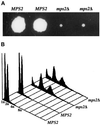
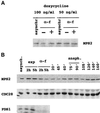
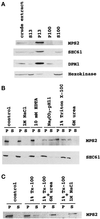
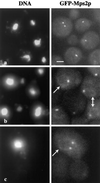
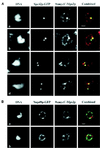
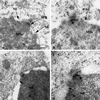
Similar articles
-
The Saccharomyces cerevisiae spindle pole body (SPB) component Nbp1p is required for SPB membrane insertion and interacts with the integral membrane proteins Ndc1p and Mps2p.Mol Biol Cell. 2006 Apr;17(4):1959-70. doi: 10.1091/mbc.e05-07-0668. Epub 2006 Jan 25. Mol Biol Cell. 2006. PMID: 16436507 Free PMC article.
-
The Sad1-UNC-84 homology domain in Mps3 interacts with Mps2 to connect the spindle pole body with the nuclear envelope.J Cell Biol. 2006 Aug 28;174(5):665-75. doi: 10.1083/jcb.200601062. Epub 2006 Aug 21. J Cell Biol. 2006. PMID: 16923827 Free PMC article.
-
A ternary membrane protein complex anchors the spindle pole body in the nuclear envelope in budding yeast.J Biol Chem. 2017 May 19;292(20):8447-8458. doi: 10.1074/jbc.M117.780601. Epub 2017 Mar 29. J Biol Chem. 2017. PMID: 28356353 Free PMC article.
-
Composition of the spindle pole body of Saccharomyces cerevisiae and the proteins involved in its duplication.Curr Genet. 2002 Feb;40(5):291-310. doi: 10.1007/s00294-001-0263-x. Epub 2001 Dec 8. Curr Genet. 2002. PMID: 11935220 Review.
-
Nuclear envelope insertion of spindle pole bodies and nuclear pore complexes.Nucleus. 2012 May-Jun;3(3):226-36. doi: 10.4161/nucl.20148. Epub 2012 May 1. Nucleus. 2012. PMID: 22572959 Free PMC article. Review.
Cited by
-
The conserved ATPase Get3/Arr4 modulates the activity of membrane-associated proteins in Saccharomyces cerevisiae.Genetics. 2006 Sep;174(1):215-27. doi: 10.1534/genetics.106.058362. Epub 2006 Jul 2. Genetics. 2006. PMID: 16816426 Free PMC article.
-
LINC complexes in health and disease.Nucleus. 2010 Jan-Feb;1(1):40-52. doi: 10.4161/nucl.1.1.10530. Nucleus. 2010. PMID: 21327104 Free PMC article. Review.
-
Extranuclear Structural Components that Mediate Dynamic Chromosome Movements in Yeast Meiosis.Curr Biol. 2020 Apr 6;30(7):1207-1216.e4. doi: 10.1016/j.cub.2020.01.054. Epub 2020 Feb 13. Curr Biol. 2020. PMID: 32059771 Free PMC article.
-
Lessons from yeast: the spindle pole body and the centrosome.Philos Trans R Soc Lond B Biol Sci. 2014 Sep 5;369(1650):20130456. doi: 10.1098/rstb.2013.0456. Philos Trans R Soc Lond B Biol Sci. 2014. PMID: 25047610 Free PMC article. Review.
-
Bringing KASH under the SUN: the many faces of nucleo-cytoskeletal connections.J Cell Biol. 2009 Aug 24;186(4):461-72. doi: 10.1083/jcb.200906068. Epub 2009 Aug 17. J Cell Biol. 2009. PMID: 19687252 Free PMC article. Review.
References
-
- Amon A, Irniger S, Nasmyth K. Closing the cell cycle circle in yeast: G2 cyclin proteolysis initiated at mitosis persists until the activation of G1 cyclins in the next cycle. Cell. 1994;77:1037–1050. - PubMed
-
- Boeke JD, Trueheart J, Natsoulis G, Fink GR. 5-Fluoroorotic acid as a selective agent in yeast molecular genetics. Methods Enzymol. 1987;154:164–175. - PubMed
-
- Brachmann CB, Davies A, Cost GJ, Caputo E, Li J, Hieter P, Boeke JD. Designer deletion strains derived from Saccharomyces cerevisiae S288C: a useful set of strains and plasmids for PCR-mediated gene disruption and other applications. Yeast. 1998;14:115–132. - PubMed
Publication types
MeSH terms
Substances
Grants and funding
LinkOut - more resources
Full Text Sources
Molecular Biology Databases

